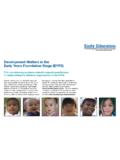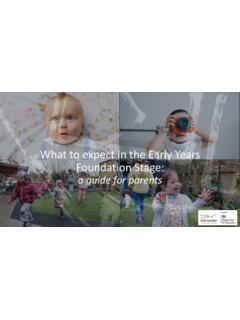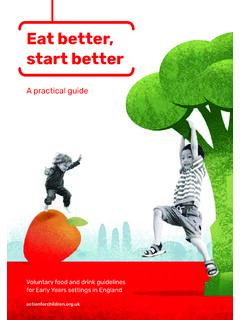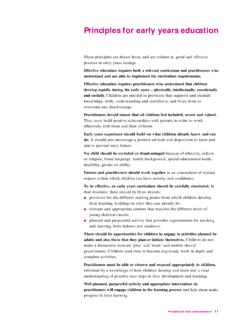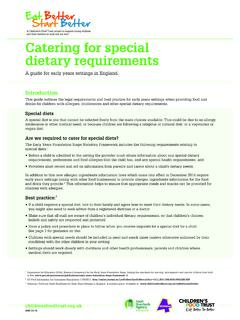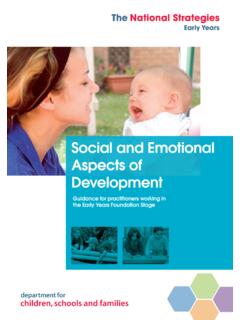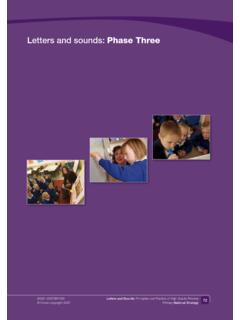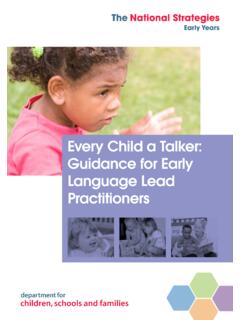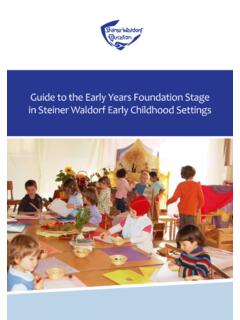Transcription of Letters and Sounds: Phase Five - Foundation Years
1 00281-2007 BKT-EN Crown copyright 2007 Letters and Sounds: Principles and Practice of High Quality PhonicsPrimary National Strategy Letters and Sounds: Phase five 0 Letters and Sounds: Principles and Practice of High Quality PhonicsPrimary National Strategy00281-2007 BKT-EN Crown copyright 2007 Letters and Sounds: Phase FivePhase five (throughout Year )Contents PageSummary 131 Suggested daily teaching in Phase five 131 Suggested timetable for Phase five discrete teaching 132 Reading 134 Teaching further graphemes for readingTeaching alternative pronunciations for graphemesPractising recognition of graphemes in reading wordsTeaching and practising reading high-frequency (common)
2 WordsPractising reading two-syllable and three-syllable words Practising reading sentencesSpelling 144 Teaching alternative spellings for phonemesLearning to spell and practising high-frequency wordsPractising spelling two-syllable and three-syllable words Practising writing sentences Assessment 150 Bank of words and other materials for use in Phase five activities 151 KeyThis icon indicates that the activity can be viewed on the DVD. 00281-2007 BKT-EN Crown copyright 2007 Letters and Sounds: Principles and Practice of High Quality PhonicsPrimary National StrategyLetters and Sounds: Phase five SummaryChildren entering Phase five are able to read and spell words containing adjacent consonants and some polysyllabic words.
3 (See Appendix 3: Assessment.)The purpose of this Phase is for children to broaden their knowledge of graphemes and phonemes for use in reading and spelling. They will learn new graphemes and alternative pronunciations for these and graphemes they already know, where relevant. Some of the alternatives will already have been encountered in the high-frequency words that have been taught. Children become quicker at recognising graphemes of more than one letter in words and at blending the phonemes they represent. When spelling words they will learn to choose the appropriate graphemes to represent phonemes and begin to build word-specific knowledge of the spellings of teaching materials in this Phase provide a selection of suitable words and sentences for use in teaching Phase five .
4 These words are for using in the activities practising blending for reading and segmenting for spelling. These are not lists to be worked through slavishly but to be selected from as needed for an must always be remembered that phonics is the step up to word recognition. Automatic reading of all words decodable and tricky is the ultimate of teaching in a discrete phonics sessionIntroduction Objectives and criteria for successRevisit and reviewTeachPractiseApplyAssess learning against criteriaSuggested daily teaching in Phase five Letters and Sounds: Principles and Practice of High Quality PhonicsPrimary National Strategy00281-2007 BKT-EN Crown copyright 2007 Letters and Sounds.
5 Phase FiveRevisit and reviewPractise previously learned graphemesPractise blending and segmentationTeachTeach new graphemesTeach tricky wordsPractisePractise blending and reading words with the new GPCP ractise segmenting and spelling words with the new GPCA pplyRead or write a sentence using one or more high-frequency words and words containing the new graphemesSuggested timetable for Phase five discrete teachingWeeks Practise recognition and recall of Phase Two, Three and five graphemes as they are learned Teach new graphemes for reading (about four per week) Practise reading and spelling words with adjacent consonants and words with newly learned graphemes Learn new phoneme /zh/ in words such as treasure Teach reading the words oh, their, people, Mr, Mrs, looked, called, asked Teach spelling the words said, so, have, like, some, come, were.
6 There Practise reading and spelling high-frequency words Practise reading and spelling polysyllabic words Practise reading sentences Practise writing sentences Weeks Practise recognition and recall of graphemes and different pronunciations of graphemes as they are learned Teach alternative pronunciations of graphemes for reading (about four per week) Practise reading and spelling words with adjacent consonants and words with newly learned graphemes 00281-2007 BKT-EN Crown copyright 2007 Letters and Sounds: Principles and Practice of High Quality PhonicsPrimary National StrategyLetters and Sounds: Phase five Teach reading the words water, where, who, again, thought, through, work, mouse, many, laughed, because, different, any, eyes, friends, once, please Teach spelling the words little, one, do, when, what.
7 Out Practise reading and spelling high-frequency words Practise reading and spelling polysyllabic words Practise reading sentences Practise writing sentences Weeks 0 Practise recognition and recall of graphemes and different pronunciations of graphemes as they are learned Teach alternative spellings of phonemes for spelling Practise reading and spelling words with adjacent consonants and words with newly learned graphemes Teach spelling the words oh, their, people, Mr, Mrs, looked, called, asked Practise reading and spelling high-frequency words Practise reading and spelling polysyllabic words Practise reading sentences Practise writing sentences Letters and Sounds: Principles and Practice of High Quality PhonicsPrimary National Strategy00281-2007 BKT-EN Crown copyright 2007 Letters and Sounds: Phase FiveREADINGIt must always be remembered that phonics is the step up to fluent word recognition.
8 Automatic and effortless reading of all words decodable and tricky is the ultimate goal. By repeated sounding and blending of words, children get to know them, and once this happens they should be encouraged to read them straight off in reading text, rather than continuing to sound and blend them aloud because they feel that this is what is required. They should continue, however, to use overt or silent phonics for words that are further graphemes for readingNew graphemes for readingay dayoy boywh whena-e makeou outir girlph photoe-e theseie tieue blueew newi-e likeea eataw sawoe toeo-e homeau Paulu-e ruleIt is probably unnecessary to continue teaching mnemonics for new graphemes.
9 As children build up their speed of blending and read more and more words automatically, many of them will assimilate new graphemes in the course of their reading. To ensure that all children know these graphemes, they should be quickly introduced through high-frequency words such as those suggested Crown copyright 2007 Letters and Sounds: Principles and Practice of High Quality PhonicsPrimary National StrategyLetters and Sounds: Phase five Example session for split digraph i-ePurposeTo teach a split digraph through showing its relationship to a known graphemeResourcesGrapheme cards t, m, p, n, and ie 2 ScissorsReusable sticky padsProcedureAsk the children to sound -talk and show fingers for the word tie while a child makes it using the grapheme the children what needs to be added to tie to make the m against the word tie thus making tiem, sound -talk it and explain that although there are graphemes for each phoneme this is not the correct spelling of time, as words like this are written slightly the ie grapheme card between the i and the e.
10 Explaining that in this word we need to separate the two Letters in the grapheme and tuck the final sound in the four Letters onto the whiteboard and draw a line joining the i and the with pie and make into or write on the whiteboard the high-frequency words that use the split digraph ( like, make, came, made). Letters and Sounds: Principles and Practice of High Quality PhonicsPrimary National Strategy00281-2007 BKT-EN Crown copyright 2007 Letters and Sounds: Phase FiveTeaching alternative pronunciations for graphemesi fin, findow cow, blowy yes, by, veryo hot, coldie tie, fieldch chin, school, chefc cat, centea eat, breadou out, shoulder, could, youg got, gianter farmer, heru but, put (south)a hat, whatKnown graphemes for reading.
